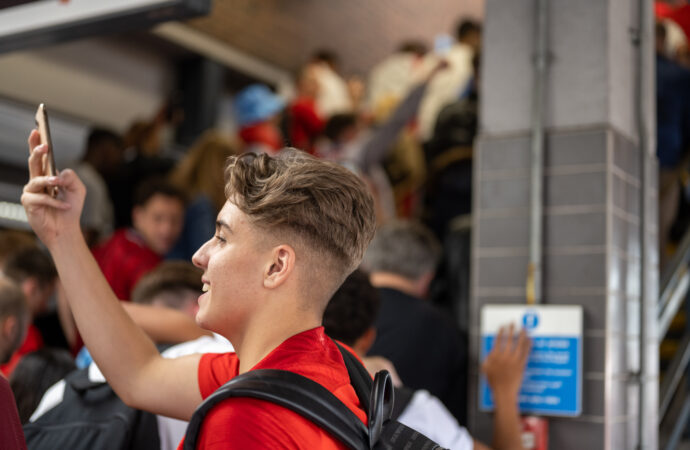Travel is sport’s wicked problem when it comes to climate credibility. But sustainable mobility can provide value-add opportunities as well as emission reduction
A decade ago, renowned Italian architect Carlo Ratti likened the evolution of cities, marked by increasing technological touchpoints, to the transformation of Formula 1 teams. In the past, success relied solely on having the best car and driver. Now, success demands a team of real-time monitoring engineers and analysts equipped with thousands of sensors in the car, transmitting data to enhance performance.
This week, the Massachusetts Institute of Technology (MIT) Senseable City Lab Dubai, which counts Ratti as a director, partnered with the Fédération Internationale de l’Automobile (FIA) to research sustainable mobility patterns, aiming to reduce carbon emissions, with one of the focuses being the Abu Dhabi Grand Prix.
In sports sustainability, a significant challenge is the carbon impact of events, largely driven by transportation. Major events strain host cities, causing traffic, disruptions and increasing emissions. Around the race, data will be gathered to inform recommendations for enhancing local mobility planning, easing congestion and reducing carbon emissions.
FIA President Mohammed Ben Sulayem emphasised the partnership’s goal: not just enhancing event sustainability and efficiency through improved mobility but also elevating the attendee experience. Transportation poses a considerable challenge for sports’ carbon impact, constituting a major portion of Scope 3 emissions, often comprising 90% of a sports organisation’s carbon footprint. Instead of avoiding the complexity, sports entities should view travel as an opportunity to enhance the spectator experience, contribute to sports aesthetics and showcase commitment to innovation.
Fan Mobility, co-founded by tennis star Mischa Zverev, asserts that sports event organising committees can enhance attendance and revenue by investing in sustainable mobility. Its study, using the Chile Open as an example, revealed that 8,000 more tickets could have been sold with improved public transport. To address this, the tournament director, Cata Filiol, has committed to increasing shuttle bus services for the 2024 edition, aligning with spectator preferences for reduced congestion and lower pollution.
Zverev, an Australian Open quarter-finalist in 2017, tells The Sustainability Report that while sports organisations and event organisers are often “afraid” of sustainability because of a perceived “high cost”, well executed plans around mobility can improve the bottom line.
The survey, conducted at ATP tournaments like Chile ATP250, Halle ATP500, Båstad ATP250, and Kitzbühel ATP250 from February to September 2023, revealed that 68% of attendees rely on cars, contributing to 88% of carbon emissions. Zverev and partner Paul Coleman aim to improve public transport accessibility for spectators using data analytics, route planning and nudging.
“Whenever you talk to someone about sustainability anywhere, they’re trying to work out how little they can do, how complicated it is going to be and how much it’s going to cost,” says Coleman. “We are at literally zero base of knowing where fans are attending sports events from.”
Coleman notes that many sports fans struggle with climate language like “net zero” and “sustainability” as it lacks aspirational appeal. To address this, Protect Our Winters Europe, through its Sustainable Mobility Hub, rebrands sustainable journeys as adventures and experiences. This initiative, showcased by its athlete community, aims to offer solutions that enhance fan experiences.
The transport sector, Europe’s second-largest emitter of greenhouse gases, contributes significantly to the tourism sector, where sports event travel is included. Transport accounts for 75% of global emissions in this sector. Adventures, as highlighted by Protect Our Winters Europe, can occur on buses (replacing around 40 cars) or trains, the most sustainable and safe mode of motorised transport in Europe.
Cars, being the most carbon-intensive land transport, has prompted a collaboration between the FIA, F1 and Extreme H, the world’s first hydrogen-powered racing championship and offshoot of Extreme E. This strategic alliance aims to assess hydrogen’s development and potential applications to reduce the carbon impact of motorsport and broader mobility.
Chaired by Mark Grain, Pat Symonds and Nikolas Tombazis, the Hydrogen Working Group will oversee the progress of hydrogen technology for fuel cells, battery systems, race site infrastructure, transportation, charging, storage and safety.
The International Energy Agency’s 2021 Global Hydrogen Review indicates limited low-carbon hydrogen production, citing cost challenges and restricted use in industry and transport. While hydrogen holds promise for sector decarbonisation, could motorsport’s involvement expedite its adoption, given governments’ need for faster, decisive action? Symonds certainly thinks so.
“Our sport has a tradition of bringing new technologies to the forefront of public perception in incredibly short timescales,” he said. “With climate change mitigation at the forefront of everyone’s mind, we are committed to promoting sustainability and therefore need to explore all areas of decarbonisation of the mobility sector. This must include sustainable liquid hydrocarbon fuels, electrification and hydrogen.”
In the near future, hydrogen-electric planes may transport fans and athletes, as envisioned by Dale Vince, Forest Green Rovers owner. His low-carbon airline, Ecojet, aims to facilitate sustainable travel for players and supporters, with plans to launch a nine-seater by 2027 for short-haul journeys, anticipating the entry of larger hydrogen planes in the 2030s or 2040s potentially.
While awaiting hydrogen plane availability, the Fly Green Alliance advocates for sustainable aviation fuel (SAF) as a more immediate solution to reduce the carbon impact of flying. In collaboration with Sokito and PAOK player William Troost-Ekong, they promote ‘green transfers,’ encouraging athletes to know their data, make or influence changes they can, such as using electric vehicles, and if they need to fly, use renewable fuels. The Fly Green Alliance’s documentary, ‘The Golden Bullet’, showcases how sports can drive greener aviation and green investments.
“With most businesses and sporting events on a growth trajectory, renewable fuels and SAFs offer an immediate solution to reduce travel-related emissions,” Sarah Wilkin, founder and chief executive of the Fly Green Alliance, tells The Sustainability Report. “SAF is now legislated in the EU with work also underway in the US.”
If 2023 was sport’s year to strengthen its relationship with nature, then in 2024 it needs to address its travel-related environmental impact, turning a challenge into an opportunity to enhance value, boost its reputation and strengthen ties with key stakeholders. Approaching this with a focus on spectator and athlete experience, alongside a commitment to innovation and research, marks a strategic shift towards sustainability and positive industry impact.
Opt into our weekly newsletter for exclusive content focused on sustainability strategy, communication and leadership for sport’s ecosystem.










Leave a Comment
Your email address will not be published. Required fields are marked with *